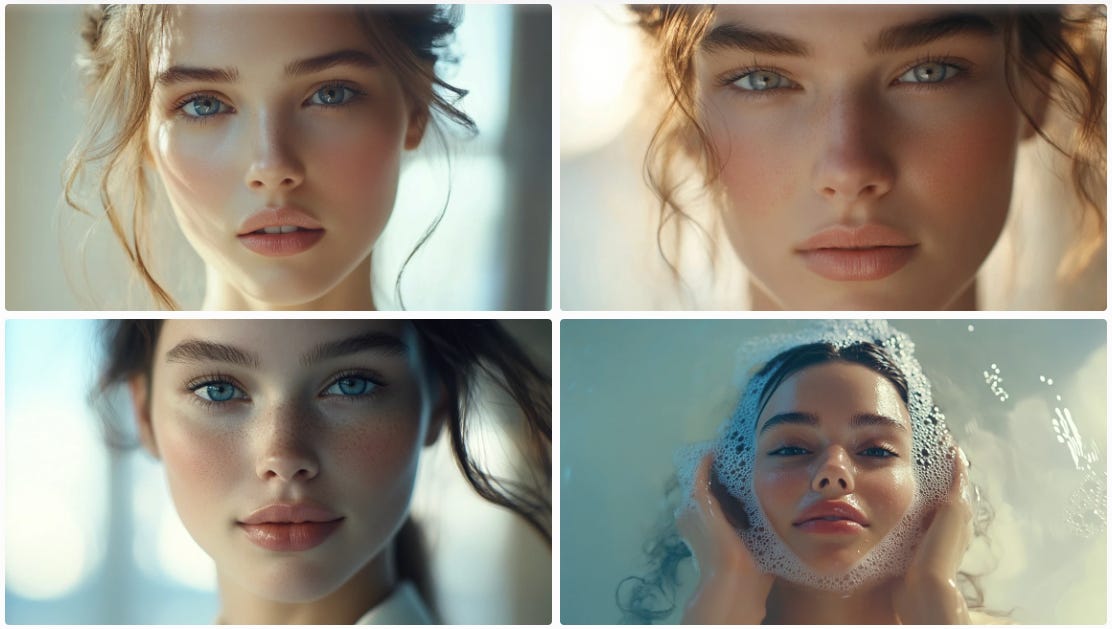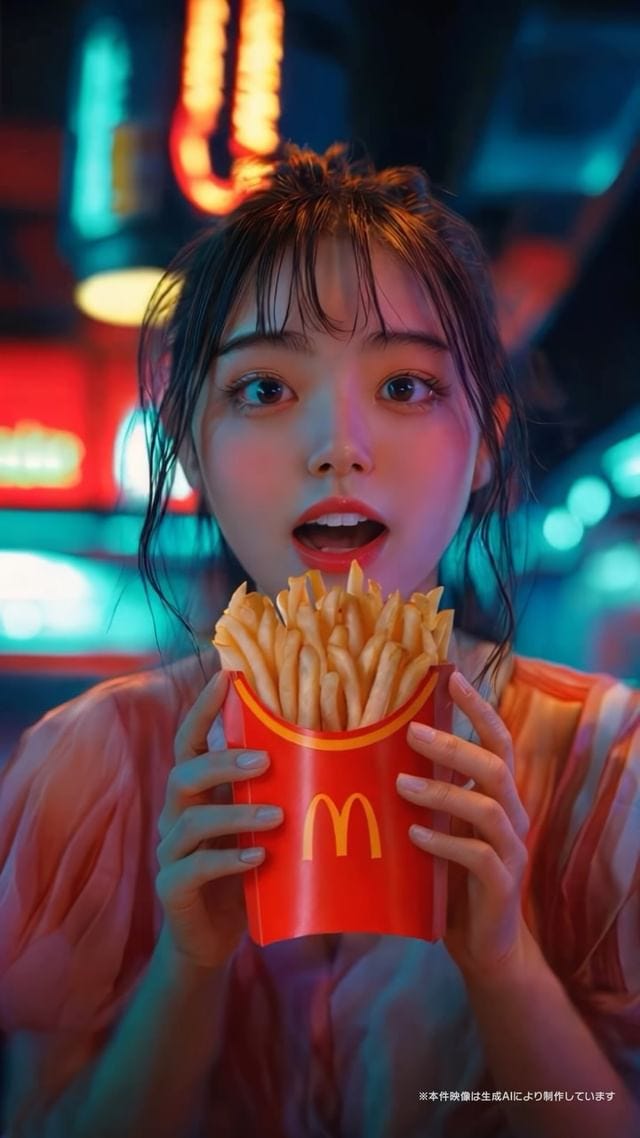The advertising industry has been quicker to experiment with using AI in its consumer-facing output than many other creative industries.
Below are 23 uses of AI in video advertising creative from the last six years followed by eight takeouts from those examples.
Creative brief
One of the first uses of AI in video advertising creative was way back in November 2018, when Lexus partnered with The&Partnership London (now T&Pm) and Visual Voice to develop ‘Driven by Intuition’. However AI’s role was fairly modest. A bespoke ‘AI scriptwriter’ wrote the (dialogue-free) ‘script’, informed by IBM Watson’s analysis of 15 years' worth of Cannes-Lions-winning car and luxury adverts, which was then handed over to Oscar-winning director Kevin Macdonald to bring to life. Whilst ‘AI scriptwriter’ was too tempting a descriptor for those involved to resist, I’d say ‘AI creative brief writer’ is a truer description of AI’s role in this early experiment.
Copy
Most AI-generated copy in ad creative isn’t signposted or easy to spot. However, in April 2023, GALERIA.ag developed a campaign for McDonalds Brazil using text attributed to ChatGPT to illustrate the Big Mac’s status as the most iconic burger in the world.
Burger King and agency David São Paulo spotted an opportunity and created some matching out-of-home creative showcasing ChatGPT’s response to its follow-up question: ‘And which one is biggest?’
Image generation
In July 2022, Heinz & Canadian agency Rethink extended their ‘Draw Ketchup’ campaign by creating ads showing what AI image generator DALL-E produced when given the prompt “ketchup”. Whilst it couldn’t quite manage to render a legible brand mark, the label design and bottle-shape suggested a clear preponderance of images of Heinz Ketchup bottles in DALL-E’s training data, enabling the ad to conclude that “Even A.I. knows that ketchup is Heinz”.
A couple of months later, in September 2022, Nestlé launched its ‘It’s so pleasurable to take the time’ ad for French yoghurt brand La Laitière. Created by Ogilvy Paris, it used DALL-E’s then novel outpainting feature to imagine the scene beyond the canvas of Vemeer’s ‘The Milkmaid’ (which has featured in La Laitière advertising and packaging since the 1970s). Pre-ChatGPT, the use of generative AI in this ad didn’t generate backlash (the calming strains of Bach’s Suite No. 1 In G Major might have helped).
Video generation
In March 2023, Coca Cola launched its ‘Masterpiece’ campaign which used a blend of AI-generated imagery, live action and traditional visual effects techniques to bring an art gallery to life. Developed by London agency Blitzworks with VFX by Electric Theatre Collective, the ad’s emulation of different painterly styles provides a fair bit of latitude in terms of AI’s rough edges. It was generally well received.
In September 2023, Hotel Chocolat released its ‘Velvetise into happiness’ ad, created by London agency Gravity Road. The fantastical nature of the visuals is more forgiving than more realistic scenarios and it tested well with viewers, scoring the maximum Star Rating in System1’s Test Your Ad platform. It wasn’t wholly AI-generated. Gravity Road also made use of “more conventional CGI”, helping to head off accusations of replacing human creatives.
In June of this year, Toys ‘R’ Us and Motorola both released wholly AI-generated ads.
The Toys ‘R’ Us ad, created by US agency Native Foreign, was the first commercial uses of OpenAI’s Sora model and got quite a kicking, both for the quality/consistency of the output and the decision not to use a human cast and crew to tell the brand’s origin story.
Motorola’s ‘Styled by Moto’, created by Paris agency heaven, used 9 different AI tools to create the visuals and audio. The fashion models who feature are very obviously AI-generated. It got a slightly less hard time than the Toys ‘R’ Us ad, although comments remain turned off on the official YouTube upload.
A couple of weeks ago, ITV announced two new ads created using generative AI, for Welsh travel company Travel House and Northern Irish furniture store Sheepbridge Interiors. The ads are intended to be a calling card for ITV’s commercial creative production service to encourage small businesses to consider TV advertising. The visuals are very clearly AI-generated, featuring crudely-animated characters (a potato and a passport) and a smattering of malformed text. Going with animation was a smart creative decision, as was the use of human voice-over artists.
Celebrity clones
In April 2019, Ridley Scott Associates Amsterdam and R/GA London made use of Synthesia’s AI cloning technology to portray David Beckham speaking 9 different languages in support of the Malaria Must Die campaign. The worthy cause, the obvious artifice (they didn’t attempt to make the non-English language voices sound like Beckham) and being upfront about the use of AI (they published a companion explainer video) headed off most criticism (favourite YouTube comment: “They are doing this first as a charity work to look like harmless force for good but what they really doing here is good publicity. So, they can leave language experts and linguist jobless. Thats the future. Then humanity is driving itself to extinction and societal collapse is inevitable by 2040 as stated by MIT”).
In October 2021, Cadbury partnered with Ogilvy India & Wavemaker India to create ‘Shah Rukh Khan-My-Ad’ personalised ads featuring Bollywood legend Shah Rukh Khan endorsing local businesses in India, whilst also promoting Cadbury’s Celebrations. Khan’s likeness was created by Rephrase.ai (since acquired by Adobe). The obvious artifice coupled with the oxygen being given to smaller business helped this to land well.
In June 2023, Virgin Voyages and VMLY&R (now VML) launched 'Jen A.I.’ a campaign which enabled would-be cruise-goers to create custom J.Lo-starring video invitations on the Virgin Voyages website. Her video likeness was developed by Deeplocal and her voice by SpeakUnique. I like to think got greenlit purely on the strength of the ‘Jen A.I.’ pun.
In July 2023, AlmapBBDO delivered a campaign for Volkswagen which reunited Grammy award-winning Brazilian singer Maria Rita with her an AI clone of her late mother, Elis Regina, a legend of Brazilian music who died in 1982, when Maria was just 4. The two are shown duetting whilst driving new and old versions of the VW Kombi van. Whilst the presence of Maria covered off the question of familial consent, the ad still generated controversy.
Avatars from voice recordings
HSBC’s November 2022 ‘Faces of Fraud’ campaign, developed by Wunderman Thompson (now VML) with help from Carnegie Mellon University, used “a pioneering AI that can identify characteristics, such as gender, ethnicity, weight and age to predict what a fraudster’s face might look like based on voice data”. Unfortunately, the AI avatars (generated using Epic Games’ Unreal Engine) weren’t very convincing by today’s standards.
Dubbing / lip syncing
Last December, hotel price comparison service, trivago, proudly trumpeted its “first-of-its-kind AI-driven television advertising campaign”, which used a single actor and AI to create the same ad with 10 “uniquely tailored, culturally relevant voiceovers”. However, the quality of the lip-syncing wasn’t up to snuff, resulting in what Skift diplomatically described as a “mixed reaction”.
Parody
Perhaps the safest ground right now is using AI in a parodic way. You get the buzz that comes from using AI without the execution needing to be perfect and without the negative halo of assumptions about impact on human creatives.
In January 2023, actor/producer/businessman/man-with-the-midas-touch, Ryan Reynolds dropped an ad for Mint Mobile (the mobile virtual network he co-owned before selling to T-Mobile for an estimated $1.35 billion) on his YouTube channel. It shows him talking through the copy ChatGPT generated when asked to write a commercial including a joke, a curse word and the key promotional messages. The video has generated over 2 million views, 64k likes and 1.5k comments.
At the other end of the cost-per-spot spectrum, this year’s Super Bowl included a number of ads riffing on generative AI’s perceived deficiencies.
A teaser for Despicable Me 4 showed some of the common issues with early AI image generation models (extra limbs and fingers, distorted faces and malformed text) with a deadpan voiceover ironically declaring “with artificial intelligence, the future is in good hands”.
BodyArmour’s Super Bowl commercial went down a similar route, with a robotic voice reeling off keywords over distorted AI-generated visuals of an American Football game, before cutting to real footage of sportspeople and a human voiceover declaring “BodyArmour knows nothing in sports should be artificial”.
One of Nestlé’s first toes in the AI-generated video water was its March 2023 KitKat campaign, by Wunderman Thompson Australia (now VML). Like BodyArmour’s ad, it used the deficiencies of early AI image generators to illustrate what would happen if flesh and blood creatives took a break.
Informing, educating and entertaining
More original was Nestlé’s KitKat Canada campaign from January of this year, which riffed on the insight that LLMs give better responses if you ask them to take their time.
Taking the moral high ground
In April of this year, Dove made a commitment to never use AI to represent real women in its ads and launched a new campaign called 'The Code’, which, er, used AI to represent real women. It suggested that adding ‘according to Dove Real Beauty Ad’ to the end of an image prompt would generate much more diverse representations of beauty. I input one of the prompts shown in the ad into the latest version of AI image generator Midjourney (output below).

Virtual influencers
Last month, McDonald’s Japan released an AI-generated ad via the Instagram account of AI art influencer Kaku Drop. The visuals, created using Luma Dream Machine, are a montage of heavily stylised, colour-saturated snapshots of girl with carton(s) of McDonald’s fries in various contexts. The soundtrack is frenetic. The payload is a 34% discount on medium and large fries for 12 days in August. It’s received 15k likes.
Takeouts
The quality bar for video is high and viewers will likely be unforgiving of any AI-generated anomalies (unless you’re parodying).
Avoid falling between two stools. Creative should either be obviously AI-generated and you’re making a comedic/educational/stylistic virtue of that or so good that the use of AI isn’t apparent.
Fantastical/obviously-not-real scenarios provide more latitude and animation is more forgiving than attempting to simulate live action.
Be honest if you’ve used generative AI to create audio or visuals, especially of people. Being ‘found out’ for undisclosed AI use in creative work can be brand damaging.
Don’t trumpet your use of AI. Hold-off the self-congratulatory press release and let the creative speak for itself (unless, like ITV, you’re trying to sell your creative production services).
Don’t hide the humans. The AI-infused ads which tend to land best show human creativity/craft supported by AI.
Be sensitive to people’s anxieties around the impact of generative AI use on flesh-and-blood creatives. Implicitly (or, if necessary, explicitly) reassure people that you haven’t fired your creative team.
Using AI-literate talent and releasing via their social channels can help AI-infused creative land better.






